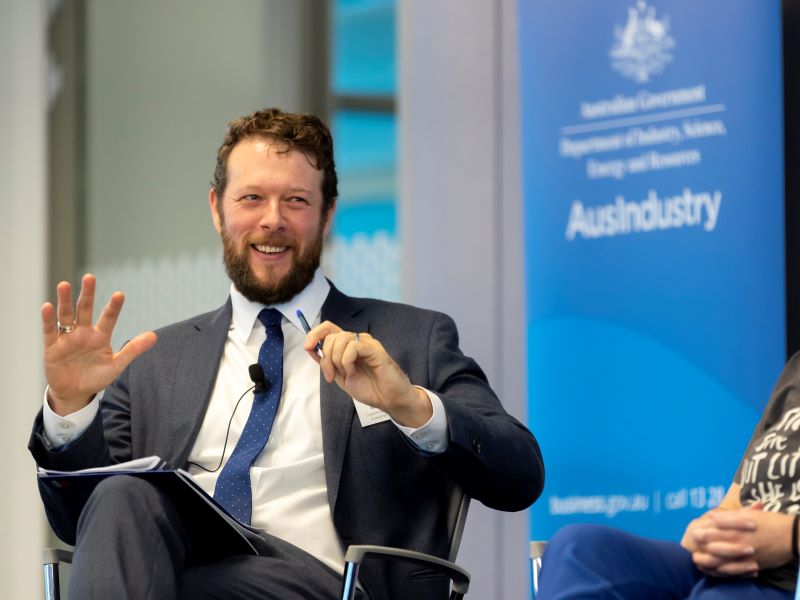New South Wales is on track to become Australia’s first trillion-dollar state economy by the end of the decade, and the government wants to get there sooner and double the mark in the following 10 years by developing innovation precincts and key sectors it says will produce better jobs, higher wages, and more complex exports.
Investment NSW this week pitched private investors on the plan, conceding venture capital remains a crucial missing piece in the state by global standards.
The pitch was the government will use its own annual $400 million R&D investment – low by both Australian and OECD standards – more strategically to develop a handful of priority areas that will “fast track” new technologies that accelerate high value sectors but also have a broader impact.
“Our strengths in material and chemistry and in healthcare mean that we’ve got a competitive advantage in implants and prosthetics,” Investment NSW chief strategy officer Eamon Waterford offered as an example to a room full of private investors in a Barangaroo skyscraper on Tuesday.

Mr Waterford was headlining an event organised by the Australian Investment Council, a peak group representing private capital of $37 billion in assets under management and a further $13 billion in in private equity and venture capital ready to deploy.
“One of the challenges and opportunities facing New South Wales is that while some of the industries here have readily accessible capital that they can access to grow to expand to become world leading, there are a lot of sectors where we do have competitive advantages that perhaps don’t get the access to capital they need,” Mr Waterford said.
“It’s quite expensive for them to get scaled up.”
The New South Wales government has identified four key technology themes – digital, materials and chemistry, biotechnology, and energy – that stretch across a dozen sectors, and 39 specific applications like quantum computing, nuclear science and fintech that the state enjoys a competitive advantage in.
The areas, detailed in a 20-year R&D plan this month, are a signal to investors of where government support is headed and where more private sector activity should follow.
“We are interested in growing particular sectors where there might be market failures that government can play a role in,” Mr Waterford told investors.
Investment NSW is spending the rest of the year trying to “catalyse” private investment in the priority areas as it builds out several innovation precincts like Sydney’s Tech Central to accelerate the entire process.
He told investors New South Wales is already an “economic powerhouse” that offers the only state in Australia with a AAA credit rating, a large, well-educated population, several world class universities, the home of most Australian startups and several tech unicorns, and a “killer combination” of excellent liveability.
Sydney in particular is already an innovation powerhouse, Mr Waterford said, and should be mentioned alongside global leaders like Tel Aviv, London and New York.
“Obviously, we always think of Tel Aviv as this amazing global leader when it comes to its innovation ecosystem. And it is, it’s really good. It’s got about $US26 billion in market cap for its unicorns. But Sydney has $US45 billion – 70 per cent higher than Tel Aviv,” he said.
“That is a story that we don’t sufficiently tell.”
Mr Waterford said it can be difficult to sell New South Wales to investors as a place of innovation because the natural advantages that cultivate the state’s image as a tourist destination can overshadow its ingenuity.
“I think sometimes that can kind of crowd out a more nuanced conversation about the enterprising nature of Australians. The fact that we have for 65,000 years basically lived in a pretty hostile to human existence space and made it work for ourselves [shows] that we are ingenious in that,” he said.
“We’ve invented Wi Fi. We do these interesting things here and that’s a message that’s harder to sell when the pictures you’ve got are beaches and koalas.”
Similarly, Australia’s perception as “the lucky country not the hardworking country” showed Australia had become complacent in promoting its innovation credentials to investors, according to Mr Waterford.
The state is also facing challenges of an ageing population and a downturn in forecasted productivity. The government’s own Innovation and Productivity Scorecard in April acknowledged below average government investment in R&D and university-industry collaboration along with the relatively low venture capital activity.
As for how success will be measured in the years to come, Mr Waterford told InnovationAus.com it boils down to innovation investment, export complexity, “good” jobs and wages.
“Unemployment is below 4 per cent. So just creating more jobs is not a particularly helpful thing for government to be doing in this environment. They’ve got to be good jobs. They’ve got to be increasing productivity jobs, they’ve got to be helping increase our economic complexity,” Mr Waterford said.
Mr Waterford said his agency is tracking all four measures, and on jobs is taking a strategic approach.
“There is a measure around creating jobs in our target sectors specifically. So there are areas where we know [we can do more]. We need more jobs in quantum [for example]. We’re not going to materially impact the unemployment rate through the quantum computing sector, but we need to grow that sector – we know that,” he said.
Do you know more? Contact James Riley via Email.

